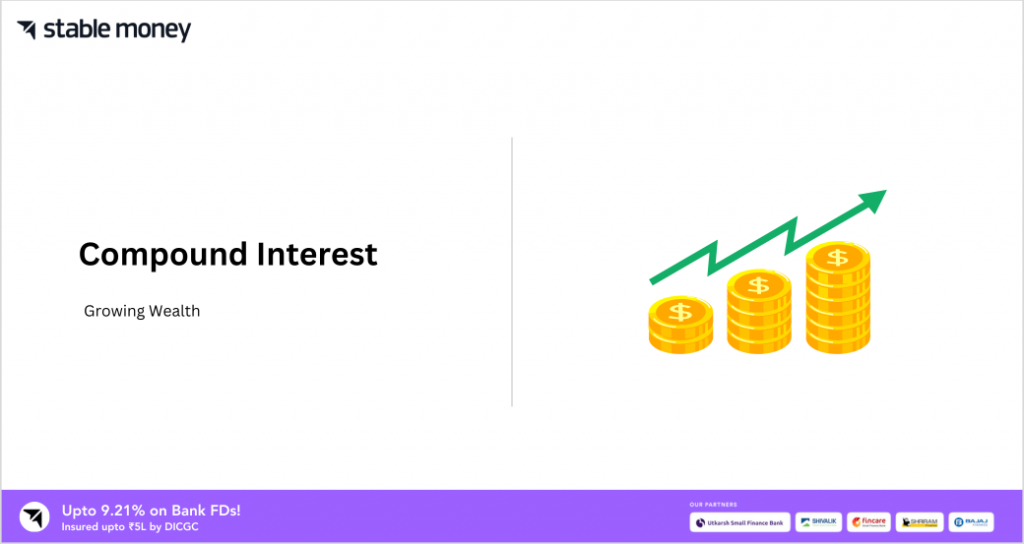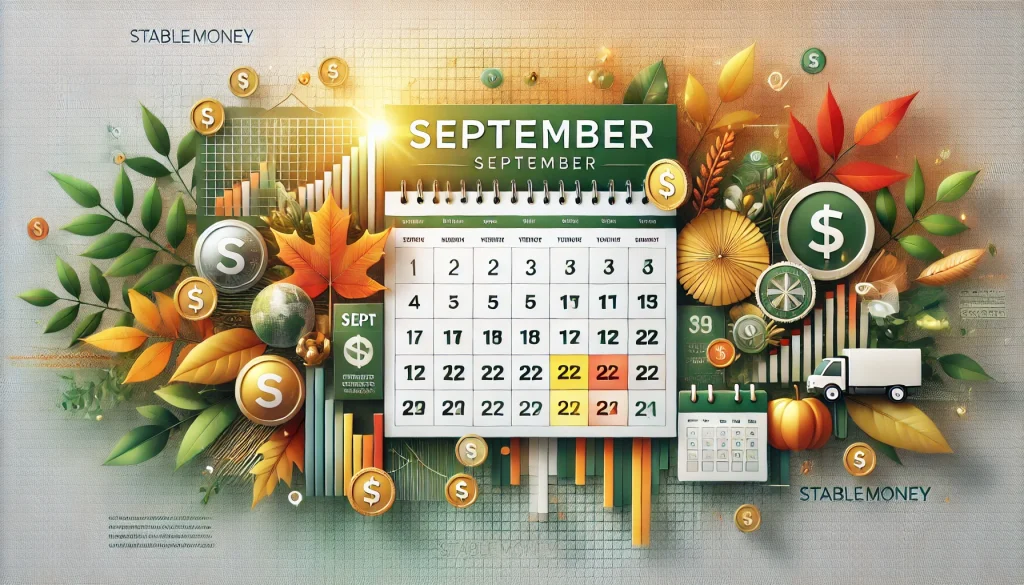
Compound interest is a powerful tool for long-term savings that has helped build wealth for generations. Through the principle of earning interest on interest, modest regular contributions can grow surprisingly large over decades. This blog explains the basics of compounding and its impact over time.
What is Compound Interest & How it is Calculated
Compound interest is the interest earned on previous interest. It makes your money grow faster compared to simple interest.
The rate at which interest compounds is called the compounding frequency, which can be yearly, half-yearly, quarterly or monthly. For example, if interest compounds yearly, interest earned in the first year will also earn interest in the second year.
The critical variables in the interest and compound interest formula are:
- Principal (P) – The initial deposit or loan amount.
- Interest Rate (R) – The interest rate expressed as a percentage.
- Compounding Period (N) – Number of times interest is compounded per year, i.e. annually, semi-annually, quarterly or monthly.
- Time (T) – Number of years the amount is compounded.
The compound interest formula is:
A = P (1 + R/N) ^ (N*T)
Where A is the final amount, including principal and interest. This formula helps to accurately calculate compound interest based on the Principal, Interest Rate, Compounding Period and Time.
What is Compounding & How the Power of Compounding Work
Compounding refers to earning interest on an interest calculator over some time. The power of compounding makes your money grow exponentially compared to simple interest. It works based on the principle that the interest you earn each period is added to the principal amount for the next period, so you earn interest on a higher amount each time.
For example, if you invest $100 at 10% annual interest, in year one, you’ll earn $10 interest. In year 2, the principal is now $100 + $10 = $110. You’ll earn 10% of $110, which is $11. Similarly, it will be 10% of $110 + $11 = $121 in year three.
How The Banks are Taking The Benefit of Compound interest
Banks can generate huge profits by taking advantage of the power of compound interest. When someone deposits money in a savings account, the bank pays them compound interest for keeping their money with the bank.
However, banks do not keep the deposited money idle. They utilise the deposits by granting loans and charging even higher interest. This interest on loans becomes the income for banks.
Banks also ensure money remains deposited for long periods by imposing penalties on preterm withdrawals. It allows them to profit from compounding over many years. From a small savers’ deposit, banks can issue larger loans due to compounding and earn significantly higher returns.
How Middle Man Can Take the Benefit of Compound interest
Like banks, even intermediaries involved in lending can leverage the power of compound interest for profit. They act as brokers by bringing lenders and borrowers together. For example, they may arrange loans from investors to businesses or individuals.
This margin allows them to profit with each loan arranged. More importantly, they get this margin to compound over multiple years till the loan is repaid. So, even a tiny margin applied to many loans can grow substantially over time.
Features & Characteristics of Compound interest
Here are some key features and characteristics of compound interest:
- Interest is earned on both the principal amount and previously earned interest.
- The more frequently interest compounds, the faster the growth. Monthly compounding gives better returns than annually.
- Higher interest rates and more extended investment periods result in significantly larger Returns due to the power of compounding over time.
- Growth is exponential rather than linear.
Importance of Compound interest
Compound interest is vital in helping investments and savings grow exponentially over the long term. Here are some reasons why compounding is so important:
- Growth Factor: It tremendously boosts long-term returns compared to earning simple interest. Even small annual returns can result in large sums when compounded for decades.
- Retirement Funds: Compounding is crucial for investments to achieve sufficient corpus for goals like retirement, children’s education or wealth creation.
- Disciplined Savings: Regular, disciplined investments take full advantage of the compounding benefit over many years.
What is Simple interest and How is it Calculated?
Simple interest is the interest calculated only on the principal amount. It does not take into account interest earned in previous periods.
The critical variables in the simple interest formula are:
Principal (P) – The initial deposit or loan amount.
Interest Rate (R) – Expressed as a percentage of principal.
Time (T) – The period for which interest is calculated in years.
The simple interest formula is:
Interest = Principal x Rate x Time / 100
Or,
I = P x R x T/100
Difference Between Simple Interest & Compound Interest
| Simple Interest | Compound Interest |
|---|---|
| Interest is calculated only on the principal amount. | Interest is calculated on principal as well as interest earned in previous periods. |
| Interest earnings do not compound or earn further interest. | Interest compounds or earns interest periodically at regular intervals, boosting returns exponentially. |
| The formula calculates interest just once at the end of the period. | The complex interest formula calculates interest multiple times – after each compounding period. |
| Returns are lower with straight-line growth. | Returns are significantly higher with exponential growth thanks to the power of compounding. |
How CI Works in Investing
Compound interest comes into play when an investment is made for the long term, and returns are reinvested. For example, when investing in mutual funds, the Net Asset Value (NAV) keeps appreciating as interest/dividends are ploughed back into purchasing additional fund units.
The power of compounding is witnessed the most over decades as small monthly sums invested in equities or debt funds can balloon into massive amounts simply by remaining invested. Investors can maximise the power of compounding by regularly contributing during ups and downs via SIPs/SWPs.
Online Calculators For Compound Interest
Many online calculators make it easy to calculate compound interest. Websites run by banks and other financial companies have simple tools to illustrate how interest compounds over time at different rates. Users can adjust the principal, rate, and term to see future values. Stablemoney.com offers a basic compound interest calculator. Enter the starting amount, yearly contribution, if any, interest rate, and number of years to see the ending balance instantly. This free calculator helps people understand how even modest, long-term savings can accumulate significantly with the power of compounding.
What Is Compounding Period & Compound Annual Growth Rate (CAGR)?
The compounding period is the frequency at which interest is applied to an account balance and reinvested. For example, if interest compounds annually, earnings from the previous year are added to the principal at the start of the new year before interest is calculated again. More frequent compounding results in faster overall growth.
The Compound Annual Growth Rate (CAGR) measures the average annual return rate over multiple years. It accounts for the effects of compound interest and allows comparison between investments that may have uneven cash flows.
Advantages & Disadvantages of CI
1. Advantages
- The snowball effect over decades yields large totals.
- Encourages long-term saving through patience.
- Builds multi-generational wealth through reinvestment.
2. Disadvantages
- It requires many years to see actual returns unassisted.
- Self-discipline is needed to avoid early withdrawals.
- Sole reliance risks lower returns if rates decline.
Final Word
Taking advantage of compound interest requires discipline, patience and steady savings practices. But the substantial returns make it well worth the effort. For individuals and societies alike, compounding provides a proven path toward achieving critical financial milestones and security for the future.
FAQs
Compound interest is earning interest on interest over time, allowing accounts to grow exponentially through reinvestment of all returns.
Compounding occurs when interest paid in one period is added to the principal, so in the next period, interest is calculated on the new, higher amount. For example, $100 at 5% annually grows to $105 in year 1, then $110.25 in year 2.
The three main types are annual, semi-annual, and continuous compounding based on how frequently interest and compounds are applied.
While it takes time to see sizable returns, compound interest is overwhelmingly beneficial when savings are maintained for decades through regular contributions and reinvestment of interest.
While returns aren’t guaranteed, stocks have the potential to compound on a more frequent, sometimes daily, basis since their values change each trading day. It allows stock holdings to grow quicker than other investments like savings accounts.
Disclaimer
This article is solely for educational purposes. Stable Money doesn't take any responsibility for the information or claims made in the blog.


